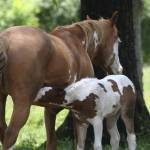Mare Obesity Impacts Foal Health and Osteochondrosis

Obesity contributes to insulin resistance, metabolic syndrome, laminitis, altered hormonal function of adipose tissue, low-grade inflammation, and decreased athletic performance in horses. In particular, obese mares produce foals with increased risk for low-grade inflammation and osteochondrosis (OC), according to European researchers.*
“Obesity continues to rise, at least in part, because many horses are now viewed as pets rather than athletes. Studies* show that owners consistently underestimate their horse’s true body condition, making it difficult to recognize overweight or obese horses and manage them appropriately,” explained Kathleen Crandell, Ph.D., a Kentucky Equine Research nutritionist.
European researchers recently explored how mare obesity at time of artificial insemination impacted foals up to 18 months of age. Obesity in that study was measured using a five-point body condition score (BCS) scale rather than the Henneke nine-point scale, in which mares were considered obese with a BCS ≥4 but normal if the BCS was <4. Mares were maintained at those BSCs throughout the duration of the study.
Key findings of the study included:
- Serum amyloid A (SAA) levels, a measure of inflammation, was elevated in obese mares at the time of parturition, whereas SAA was normal in nonobese mares;
- No difference in the foals’ postnatal growth was observed between the two groups of mares; however, elevated SAA levels were measured in foals from obese mares from birth until 6 months of age;
- Foals from obese mares were more insulin resistant than foals from nonobese mares; and
- Significantly more foals from obese mares were diagnosed with OC. Specifically, 7 of 13 foals from obese mares had OC compared with only 1 of 10 foals from nonobese mares.
“Together, these evidence-based research efforts highlight the need to maintain an appropriate BCS in all horses, especially pregnant mares, as a less-than-ideal maternal environment can impact the long-term health of the foal,” summarized Crandell.
A successful weight loss program typical involves both caloric restriction and exercise. Need help determining what an appropriate diet is for your horse? Contact a Kentucky Equine Research nutrition consultant.
“A nutritionist can help determine what amount of forage should be offered and whether a vitamin and mineral supplement, such as Micro-Max from KER, might be indicated,” Crandell said.
In Australia, look for Gold Pellet, Nutrequin, or Perform.
*Robles, M., E. Nouveau, C. Gautier, et al. 2018. Maternal obesity increases insulin resistance, low-grade inflammation and osteochondrosis lesions in foals and yearlings until 18 months of age. PLoS One. 13(1):e0190309.
**Potter, S.J., N.J. Bamford, P.A. Harris, et al. 2016. Prevalence of obesity and owners’ perceptions of body condition in pleasure horses and ponies in south-eastern Australia. Australian Veterinary Journal. 94(11):427-432.








